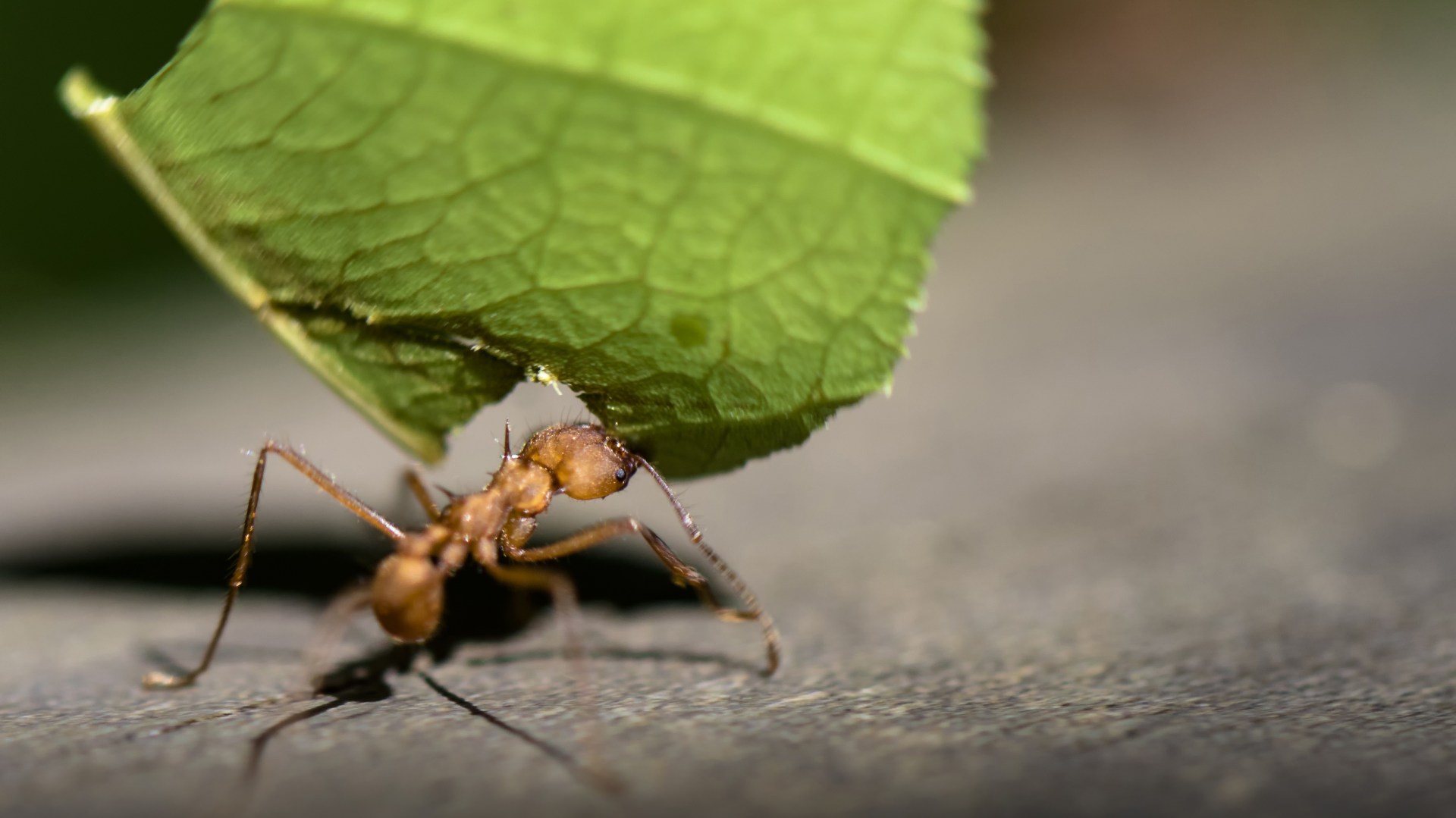Go to the ant, you sluggard; consider its ways and be wise! It has no commander, no overseer or ruler, yet it stores its provisions in summer and gathers its food at harvest. (Prov. 6:6–8)
If a congress of naturalists were to gather to choose the seven wonders of the animal world, they would be compelled to include the bizarre and mighty civilizations of the attine leafcutters.
Throughout the tropical and subtropical regions of the New World, these insects dominate forests, grasslands, and pastures. Anywhere you travel on the mainlands of Central and South America, from the wild interior to plazas and vacant lots in the hearts of cities, you will soon encounter leafcutters.
What will catch your attention at first are massive lines of relatively large reddish brown worker ants. They run in columns as wide as ten ants abreast, and as tight as soldiers double-timing in a parade. They travel on miniature highways the width of a human hand, which they keep bare of vegetation and debris. Some are outward bound; a roughly equal number are homeward bound. Most among the latter carry a freshly cut section of a leaf or flower petal, which they grip in their mandibles and direct back over their bodies like umbrellas. These are the “parasol ants,” local people in Texas and Louisiana will tell you.
Look closely at the burdened ants, and you are likely to see pygmy replicas riding as hitchhikers on the transported leaf fragments. Do these miniature ants act like mahouts to guide their big nestmates home? No, their role is even stranger: they serve as living flywhisks. Ant columns attract parasitic flies that are deadly. They descend like dive-bombers and, if unimpeded, lay eggs upon or near the necks of the big ants. The maggots that soon hatch work their way into the bodies of the ants and consume their tissues. The flywhisk guardlings prevent this action by standing on top of their leaf-carrying sisters and striking at the flies with their front legs and mandibles.
If you follow the caravan of laden ants, they will bring you to the nest. It might be fifty or even more than a hundred meters down the trail. The trip may take you through dense under-growth, and perhaps a steep little ravine or two. Inevitably and often suddenly, the nest comes into view. It is a city of millions, a subterranean metropolis. Above it is a circular dome of excavated soil that rises two meters or more. In the underground, the ants have excavated thousands of chambers roughly the size of a human head, more precisely from a thirtieth of a liter to fifty liters in volume. All are connected by a labyrinth of tunnels. The chambers are filled with a fluffy gray mass. Their thin walls are built to create the maximum surface per unit of volume.
Upon the walls grows a species of fungus that exists exclusively in symbiosis with agricultural ants such as the leafcutters and their evolutionarily less advanced close relatives. The fungus only rarely develops a mushroom with a stalk and cap. Instead, it proliferates in the form of mats of threadlike hyphae. The walls of the cells upon which the fungus feeds are built from a paste, like papier-mâché. This substance is manufactured from the fragments of vegetation brought in by the foraging workers.
Aside from plant sap obtained from freshly cut vegetation, the leafcutters subsist entirely on the cultivated fungus. They have invented a method of converting fresh vegetation, a material the digestive system of ants cannot handle, into an edible food product. The leafcutter ants are partly comparable in achievement to human agriculturists. And they have attained a breakthrough of organic evolution: by utilizing fresh vegetation on which to grow their crops, they have tapped into a virtually unlimited food source. The interdependence of the leafcutters and their fungus is one of the most successful symbioses of all time.
The ants are the principal consumers of living plant material and therefore a dominant force in the land environments of the American tropics. A full-grown colony consumes approximately the same quantity of plant material as a cow. Through much of tropical America and wherever the ants can invade gardens and cropland, they are the principal insect pests of agriculture. And so all within their great range know them. They are the saúva of Brazil, isaú of Paraguay, cushi of Guyana, zampopo of Costa Rica, wee-wee of Nicaragua and Belize, cuatalata of Mexico, bibijagua of Cuba, and town ant or parasol ant of Texas and Louisiana.
Leafcutter colonies can best be understood scientifically as complex organic structures with a single purpose: the conversion of plant life into more colonies of leafcutter ants. They are civilizations designed by natural selection to replicate themselves in as many copies as possible before their inevitable death. Because they possess one of the most complex communication systems known in animals, as well as the most elaborate caste systems, air-conditioned nest architecture, and populations in the millions, they deserve recognition as Earth’s ultimate superorganisms.
They are all the more remarkable for consisting entirely of a queen mother and her daughters. Males are reared only seasonally, and then in a tiny minority, and serve merely to inseminate virgin queens during nuptial flights away from the nests. Then they die, by design of their bodies and instinctive behavior. If visitors from another star system had visited Earth a million years ago, before the rise of humanity, they might have concluded that leafcutter colonies were the most advanced societies this planet would ever be able to produce.
Excerpted from The Leafcutter Ants: Civilization by Instinct. Copyright 2011 Bert Hölldobler and Edward O. Wilson. Published by W. W. Norton & Company. Used with permission. All rights reserved. This selection may not be reproduced, stored in a retrieval system, or transmitted in any form by any means without prior written permission of the publisher.










